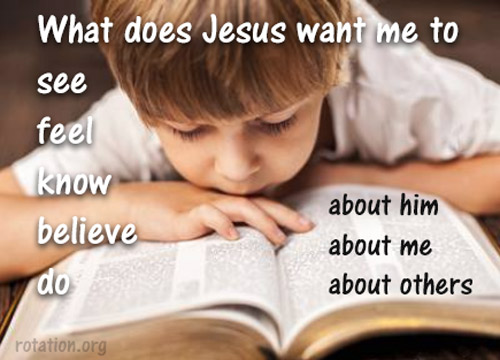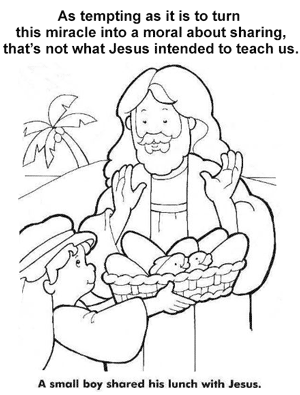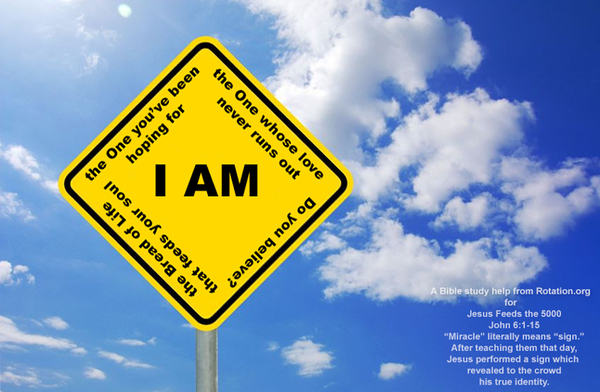Jesus Feeds the 5000
A Rotation.org Writing Team Lesson Set
Bible Background and Lesson Objectives
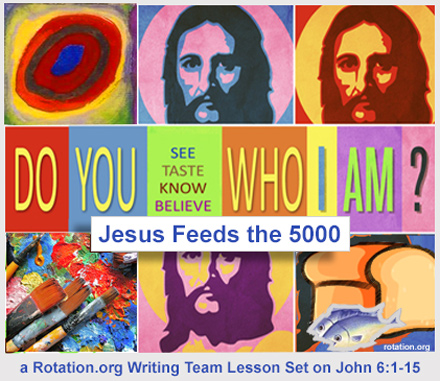
Scripture
John 6:1-15 (NIV)
The story of Jesus feeding the 5000 is one of only two stories found in all four Gospels, the second being the story of the Crucifixion.1 The four versions are nearly the same in all four Gospels—a distinction many multi-Gospel stories do not share. Certainly, these facts speak to both the importance and veracity of the event. However, John's version of the story includes two unique additional recollections.
We have chosen to go with John's version of the story for two reasons, one minor and the other quite important.
1. John is the only version of the story to include the brief detail of the small boy with bread and fish. As you will read in the background below, this is a minor addition to the story which should not distract from the miracle's more important main message.
2. John's version is the only one that ADDs an explanation of the PURPOSE of the miracle. In his concluding verses (14 and 15), John refers to the miracle as a "sign" to which the people respond, "Surely this is the Prophet who is to come into the world." Indeed, chapter 7 of John continues to tell us the significance of the Loaves and Fishes sign—that Jesus is indeed the One, he is the Bread that lasts.
Your choice of translation won't affect the meaning of the story that much, just the readability by your students. The NIV and NRSV translations of this story are both very similar and while predictably less child-friendly they are fine. The New Living Translation does a good job in this passage for younger children without losing any key phrases or vocabulary.
Memory Verses:
The first memory verse describes the miracle in two sentences. The second describes the message of the miracle.
"Jesus took the bread, gave thanks to God, and distributed it to the people who were sitting there. He did the same with the fish, and they all had as much as they wanted." (John 6:11 NIV)
"Seeing this miracle that Jesus had performed, the people there said, “Surely this is the Prophet who was to come into the world!” (John 6:14 NIV)
In addition, some workshop lessons will reference Jesus' words spoken later in John 6:35, "I am the Bread of Life."
Lesson Objectives
This story has one main meaning and several other insights to be touched on.
1. Each student will be able to recite the story at a level of detail appropriate for their age and ability.
2. Each student will be able to define the meaning of the word "miracle" as "sign," and will know and be able to share what the message of that sign tells us about Jesus–that he is indeed the promised one. (John 6:14)
3. After learning about the sign, each student will reflect on their own personal response to what they think Jesus wants them to see and feel, know and believe, and do in response to the sign which he has now given to them.
What the story is really about
What were the people really hungry for?
(What is your soul hungry for?)
What did Jesus really feed them that day?
(How does Jesus open your eyes and feed your faith?)
It is so tempting to teach the Feeding of the 5000 as a warm ethical allegory about a small boy sharing his lunch with Jesus and others, "...and therefore we should too." We've all heard sermons and lessons that have done just this. Some have even turned it into a parable of stewardship, "Give what we have and trust Jesus to multiply your gift."
But "sharing" and "multiplying" are not what this miracle story is primarily about. In fact, John explains the meaning of the miracle in verse 14, and Jesus himself explains it in verses 32-35.
John 6:14
"Seeing this miracle that Jesus had performed, the people there said, 'Surely this is the Prophet who was to come into the world!'”
Meaning: To the people who saw the miracle, it was a sign that Jesus had been sent by God. "The Prophet," "The One," perhaps even "The Messiah." (See more about this below.)
 To make this meaning even more obvious, John's Jesus further explains later in the chapter:
To make this meaning even more obvious, John's Jesus further explains later in the chapter:
John 6: 32-35
"It is my Father who gives you the real bread from heaven. For the bread that God gives is he who comes down from heaven and gives life to the world.”
“I am the bread of life,” Jesus told them. “Those who come to me will never be hungry; those who believe in me will never be thirsty."
 And just in case you didn't catch the meaning the first two times, John's Jesus goes on to describe HIMSELF as the BREAD.
And just in case you didn't catch the meaning the first two times, John's Jesus goes on to describe HIMSELF as the BREAD.
John 6:48 and 51
"I am the bread of life."
"I am the living bread that came down from heaven."
In the rest of the sixth chapter of John, after the story of the 5000, John makes an even stronger point about what Jesus "feeds us" with -- Himself.
It isn't wrong to teach "sharing" and "multiplying gifts" to our kids, but our first task as interpreters of any story is to teach the meaning which the scripture itself explains. And as we can see in John's 6th chapter, the meaning is pretty clear—the miracle of the Loaves and Fishes was intended to reveal Jesus' identity and seek our response.
Do you see, taste, know, and believe who I am?
"...the one "who is coming into the world" (John 6:14)
Do you believe Jesus is the Bread of life?
And if so, what are you doing to change your life and spread this good news to others who also hunger?
But what about the cute kid? 
It's natural and traditional to want to focus on the small boy in the story because it's one of the few times children are even mentioned in the Gospels. But instead of turning him into a "role model of sharing," we are on firmer interpretative and discipling ground when we use the boy's presence to ask questions about what he was looking for, what he found, and what he might have done afterward to follow his Savior.
Here is a sample "progression" of questions that lead to the main question of "how does encountering and believing in Jesus change us?"
- How do you think the boy felt when he was asked to help Jesus? When you are asked to help here at church, how does that make you feel? How can helping others make you feel closer to Jesus?
- Do you think the boy believed in Jesus after he saw the miracle? What questions do you think were on his mind? (Do you believe? What questions would you ask Jesus?)
- How do you think the boy's life changed after he met Jesus and saw the miracle? (Do you feel like you have "met" Jesus? And if so, how has your faith in him changed your life?)
- How do we "see" and experience the presence of Jesus today? (What things do you do to talk and listen to Jesus?)
Digging Deeper...
A miracle is literally a "sign," a message
The word for "miracle" in the New Testament original Greek is sémeion (say-mi'-on), which means "sign" or "mark." The two Old Testament Hebrew words most frequently used for “miracle” are translated “sign” (oth) and “wonder” (mopheth).
In modern times, we tend to use the word "miracle" to describe a supernatural event that has happened or we hope God will make happen. We pray for a return to good health for example. A modern Christian wouldn't think of praying for a healing miracle if what he or she really wanted was a sign or message -- he would pray for a sign or message. But in biblical text and thought, miracles are signs of the presence and authority of God, not "gifts" bestowed on a lucky few. You might recall that in other miracle stories, Jesus was questioned "by what authority" he healed and forgave. Indeed, it was the claim he was making about himself when he performed miracles that became the central charge against him at his trial. Jesus performed miracles as a sign of his identity and proof of his authority, and that's what got him in trouble with "the authorities." Ultimately, it was this claim to being "one with the Father" that sentenced him to death for blasphemy.
After the people saw the sign Jesus performed, they began to say, “Surely this is the Prophet who is to come into the world.”
It's an interesting phrase, "The Prophet who is to come." Moses was considered a prophet, and Moses presided over the miracle of the manna and quail in the wilderness. Is Jesus the promised one who would be even greater than Moses? The multiplication of the loaves and fishes answers that question.
The revelation of Jesus' identity in the Feeding of the 5000 is part of a larger theme and section in John's Gospel revealing Jesus' identity and illustrating the divisions that Jesus' teachings were causing. Preaching at the Feast of Tabernacles in John 7:31, "many in the crowd believed in him. They said, 'When the Messiah comes, will he perform more signs than this man?'" (John 7:31) And in verse 40, some at the Festival make the same claim spoken at the Feeding of the 5000, "On hearing his words, some of the people said, 'Surely this man is the Prophet.' Others said, 'He is the Messiah.' Still, others asked, 'How can the Messiah come from Galilee?'"
Interestingly, John the Baptist asks this same question in Matthew 11 when he sends his disciples to Jesus asking, "Are you the one who is to come, or should we expect someone else?” And what does Jesus tell the disciples of John? To look at his miracles. Check it out.
Teacher? Prophet? Messiah? King?—just like the people then, that is the question each of us in the "crowd" today needs to answer today.
Questions to ask your students:
- Who is Jesus?
- What is he here to do?
- Have you told Jesus who you think he is? Why is it important to do that?
- Have you told others who you think Jesus is? Why is it important to do that?
- What changes in your life have you made, or do you need to make, in order to SHOW that you are indeed a follower of Jesus?
Some More Questions You Might Ask:
In addition to the questions mentioned above, you might also ask the following in a deeper discussion or reflection:
- What different crowds are you part of? (Family, school, team, friends, church)
- How does a person become part of the "Jesus crowd"? (By believing, not just by showing up.) What are some of the expectations of being in Jesus' crowd?
- How is Sunday School and Worship like a day in the crowd listening to Jesus? Is being "part of the crowd" good enough for following Jesus, or do you need to make a personal commitment?
- Has Jesus ever personally told YOU who he is? How does that happen? What might/did he say to you? How do you suppose it will make you feel?
- Have you or someone close to you ever experienced or asked for a miracle? Did the miracle happen?
- Remembering that miracles are "signs" or messages from God, do you think miracles happen a lot? or just a little? (Explain)
- What kinds of miracles should we be praying for?
Some deeper study notes for teachers...
Avoid Teaching "Hidden Messages"
When interpreting his miracles and teachings to children, it is best to avoid teaching scripture like it's a chapter in the Da Vinci Code. While the discussion of the "numbers" and possible allegorical meanings of this story is interesting (and typical preaching fodder), they are merely the story's "objects" and not the subject. When we stick to the plain truth of what Jesus is saying rather than supposed hidden meanings, we almost always find ourselves on solid interpretative ground, and on solid developmental ground with regard to our students' needs.
Here are some answers and thoughts about some of the story's "objects."
Why 5000? Nobody, including the scholars, agrees on what "5000" means, other than, 5000 means "a lot of people." Matthew and Mark say it was 5000 men, but surely there must have been some women and children there. Luke says, "about 5000"—which is imprecise enough to let you know that Luke doesn't think much of the number other than "it was a lot." If you include women and children, some calculate ten to twenty thousand in the crowd. Could an un-miked Jesus have been heard by so many people? 5000 is possible in the perfect location, but 10,000? (That would have been the miracle, too.) The truth is that the story has nothing to do with how many people were there. Five hundred would have been just as miraculous. "Wherever two or three are gathered" is good enough for Jesus.
What we should teach about the "5000" is that a lot of people did seek him out! Are you? There's a crowd that thinks Jesus is a "great teacher," but he showed them something more about himself. Are you "hanging back" in the crowd or stepping forward?
Why fishes and loaves? Probably because there was no McDonalds nearby. Seriously! Fish and bread would have been a common portable lunch for people living near the Sea of Galilee. The first miracle is that people stayed to listen to Jesus even after their food had run out The second is that Jesus can use ANYTHING to make a lesson worth remembering. In children's education, we would call this an amazing "object lesson."
Bread and fish are symbols in the Church, and Jesus called his disciples to be "fishers of men." But we have to be honest and say that the "sign of the fish" would probably have been totally lost on those gathered there that day. So we probably shouldn't overplay the symbolism of the fish in this story because John's Jesus never refers to fish as being anything more than fish.
The bread, however, is a different matter. Not long after the Feeding of the 5000, Jesus explains in John 6:48 that HE is the Bread come down from heaven. It's important to remember that the writers of the Gospels wrote MANY DECADES after these events, and undoubtedly over time found new significance in the words and actions of Jesus. In the case of John, he obviously wants us to "connect the dots" between the bread in the miracle and Jesus being the bread of life.
Why 5 loaves and 2 fishes? The number 5 was so unimportant to the early church that the famous mosaic of the loaves and fishes (seen below) which was created circa 350 A.D., on the floor of the Tagba Church on the Sea of Galilee, where the miracle was said to have taken place—only shows 4 loaves. Interestingly, the mosaic was commissioned by a Jewish convert to Christianity by the name of Joseph. He had been a rabbinical scholar and member of the Sanhedrin. If four was enough for him and the early church, then any number of loaves is fine by us.
Was Jesus foreshadowing Communion when he blessed the loaves and fishes? Probably not, unless your church serves fish in Communion. But it's helpful to note that Jesus modeled thankfulness for what he had, rather than complain about it not being enough. And while John doesn't include the Luke-only story of the Disciples on the Road to Emmaus, there is a thematic connection between Jesus revealing himself to the 5000 through the miracle of the fishes and loaves, and Jesus "opening the eyes" of the two travelers to whom he gave bread.
Jesus is the One who opens eyes and satisfies our hunger.
Why 12 baskets full? Okay, 12 is the number of disciples and tribes of Israel, and some books of the Bible (and preachers) do make a big deal over the numbers of things. But ask yourself this question: Would the story's meaning be any different if only 10 baskets were passed and 10 returned full? No.
During our lesson brainstorming, we also came across the idea of "crumbs" being collected in the baskets, and we couldn't identify where that specific word had come from. A children's Bible perhaps? The Greek word here is the word for "pieces" and the Greek word for "crumbs." The point is ABUNDANCE, and that is a major theme of Jesus' teaching about the Kingdom of God. There's going to be enough love and forgiveness for everyone.
Why did Jesus tell his disciples "you give them something to eat." Some suppose this was a cryptic message from Jesus to the future church to do his work. But it is more likely that Jesus simply meant, "go see what you have to give them," knowing they wouldn't be able to get enough, and once again making the miracle about his ability and not theirs.
What does the small boy represent? NOTHING according to Matthew, Mark, and Luke who don't mention him. Why does John mention him? The simplest answer is that the detail was remembered by John and provided some drama, a small boy with a small lunch means this will be a great miracle. It's a nice thought to think that a small boy's lunch is symbolic of our gifts to Jesus. But it is Jesus' gift of "seeing" who he is that is the greatest gift. So a better question about the small boy is what did he believe and do after he had experienced the One they had been looking for?
This "toasted bread" mosaic brings up an interesting point about the metaphorical meaning that can be applied to "objects" in a story (such as the bread, fish, baskets). Like the toast in the mosaic, Jesus used the bread, fish and baskets to paint the message he wanted them to receive. Through the fishes, loaves, and baskets, we see Christ. (Artist unknown)
Yes, there might be a slightly "hidden" reference to Psalm 23 in the story!
All four Gospels record the curious detail that Jesus commanded the crowd to sit down. And all four also note that there was "grass" upon which to do so. Curiously, the Gospels writers do not use the Greek word for "sit" ("kathizo"). Instead, they use the Greek word for "recline" or "lie down" ("anaklino"). Did Jesus invite his sheep to "lie down in green pastures"? All four Gospels use "lie down" in "grass" but Mark seems to want to make sure we "get" the allusion to the Psalm 23 by adding Mark 6:34, "And Jesus had compassion for them because they were like sheep without a shepherd."
What's NOT hidden in the story to students of the Bible
You can often discover more about a Bible story's meaning by looking at the stories intentionally grouped around it, and such is the case with the Feeding of the 5000 in all four Gospels.
In all four Gospels, the Feeding of the 5000 is immediately followed by another major "sign" of Jesus' identity.
- In Matthew, Mark, and John, it's Jesus walking on water. And as mentioned, John 7 goes further into the question of Jesus' identity which begins to cause divisions.
- In Luke, it's the story of Jesus' transfiguration and conversation with Elijah and Moses. (More about that important connection in a moment!)
Mark's version of the walking on water story ends with a direct reference to the Feeding of the 5000 story. Jesus says to them, "Do not be afraid, it is I." But they didn't understand what they had just seen, says Mark 6:52, just like "they did not understand about the loaves." Understand what? Understand that Jesus was the One, the Messiah, the great "I am."
In Matthew's version of the walking on water miracle, the Disciples DO understand. "Truly you are the Son of God," they say, which sounds a whole lot like the response of the people after the Miracle of the Loaves and Fishes in chapter 6, verse 14, "Surely this is the Prophet we've been waiting for."
Luke 9 follows up the "Feeding of the 5000" story with TWO more identity stories.
After the miracle, Jesus is once again with his disciples, and he questions them, saying, “Who do the crowds say that I am?” And the ones, having responded, said, “John the Baptist; and others, Elijah; and others, that some prophet of the ancients rose-up”. And He said to them, “But who do you say that I am?” And Peter, having responded, said, “The Christ of God.”
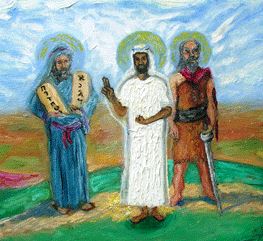 Then almost immediately Luke 9:28 goes into the story of the Transfiguration of Jesus in which Jesus appears with the two superstars of the faith, Elijah and Moses. Elijah was the prophet expected to appear when the Messiah came; recall that Jesus was asked in John 1:21 if he was Elijah. Moses was, of course, the great law-giver of the Exodus, but to Jews in Jesus' day, he too was known as a prophet. To those familiar with the Hebrew scriptures, as apparently Luke's readers were, the multiplication of the loaves and fishes such that they didn't run out would have also been a clear reference to the story of Elijah's miracle in Zarephath where he made the flour and oil (used to make bread) to continually flow (1 Kings 17). And they would have recalled Moses and the Bread from Heaven raining down upon the Israelites in the wilderness (Exodus 16). All of which is to say, you can't fully understand the story of the 5000 merely on its own. Jesus connected the dots between scriptures, and so should we.
Then almost immediately Luke 9:28 goes into the story of the Transfiguration of Jesus in which Jesus appears with the two superstars of the faith, Elijah and Moses. Elijah was the prophet expected to appear when the Messiah came; recall that Jesus was asked in John 1:21 if he was Elijah. Moses was, of course, the great law-giver of the Exodus, but to Jews in Jesus' day, he too was known as a prophet. To those familiar with the Hebrew scriptures, as apparently Luke's readers were, the multiplication of the loaves and fishes such that they didn't run out would have also been a clear reference to the story of Elijah's miracle in Zarephath where he made the flour and oil (used to make bread) to continually flow (1 Kings 17). And they would have recalled Moses and the Bread from Heaven raining down upon the Israelites in the wilderness (Exodus 16). All of which is to say, you can't fully understand the story of the 5000 merely on its own. Jesus connected the dots between scriptures, and so should we.
And in case you missed the point of John 6, John 7 makes it plain!
The meaning of John 6's story of the 5000 and Jesus declaration of himself as the "Bread from Heaven" is explained in John 7 when the crowds at the Feast in Jerusalem wonder aloud if he is the One.
What about you? Who do you say I am?
This is the "question of questions." "What about you. Who do you say that I am?" And though it is plainly asked by Jesus in Matthew 16 and Luke 9, in truth this is the question that should be at the heart of every Sunday School lesson. That's the difference between teaching Jesus as history and sharing Jesus as Savior.
Sometimes the crowds answer the question as they did in John's version of the Feeding of the 5000. Other times the question is asked by the Scribes and Pharisees,"By what authority do you....?" When the disciples see him calming the storm, they ask, "What manner of man is this, that even the winds and the sea obey him!" When the Centurion saw how Jesus died, he said, "Surely this man was the Son of God."
All that's missing from this story's message is our response.
Final Thoughts
You can see why the story was remembered in all four Gospels. What an exciting day it must have been.
And the thing is, it's a story that has happened before, and continues to happen wherever 2 or 3 or 5000 hungry souls are gathered.
Remember the wedding in Cana? ...the flour and oil in Zarephath? That time the bread literally fell out of the sky in the wilderness? Every miracle is a message both literally and figuratively that points to God and asks for our response.
Jesus asks, Who do you say that I am? ...and waits for our response.
Written for the Rotation.org Writing Team by Rev. Neil MacQueen
With input from Writing Team members.
End Notes
1 Regarding the only two stories found in all four Gospels... Most New Testament scholars accept that Mark's Gospel originally ended at 16:8 before the resurrection summary.

